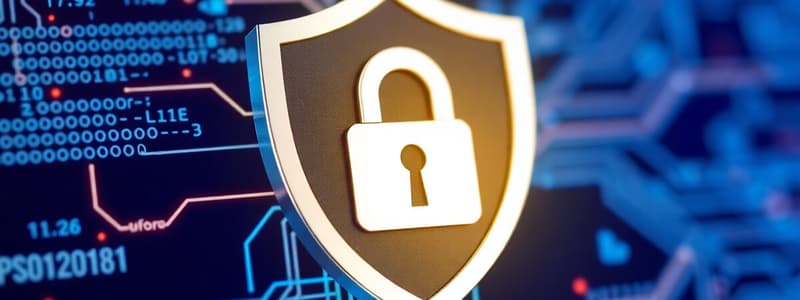Podcast
Questions and Answers
The guiding principle of protection states that a subject should be given just enough ______ to perform their task, limiting potential damage.
The guiding principle of protection states that a subject should be given just enough ______ to perform their task, limiting potential damage.
privilege
A ______ attack involves a malicious program inheriting user privileges to perform unauthorized actions on behalf of the user.
A ______ attack involves a malicious program inheriting user privileges to perform unauthorized actions on behalf of the user.
trojan horse
______ access control is a protection system that can only be modified by trusted administrators, providing a higher level of security than discretionary controls.
______ access control is a protection system that can only be modified by trusted administrators, providing a higher level of security than discretionary controls.
Mandatory
In mandatory protection, subjects and objects are represented by ______, influencing the operations a subject can perform on an object.
In mandatory protection, subjects and objects are represented by ______, influencing the operations a subject can perform on an object.
The goal of ______ limits which objects a process can read, thereby protecting sensitive information from unauthorized disclosure.
The goal of ______ limits which objects a process can read, thereby protecting sensitive information from unauthorized disclosure.
Achieving both secrecy and integrity in access control requires defining what rights an entity has for a set of objects, which is the purpose of an ______ system.
Achieving both secrecy and integrity in access control requires defining what rights an entity has for a set of objects, which is the purpose of an ______ system.
A ______ from one access matrix state to another involves adding or deleting subject, object, and operation assignments, modifying access permissions.
A ______ from one access matrix state to another involves adding or deleting subject, object, and operation assignments, modifying access permissions.
The principle that rights cannot be granted if the grantor does not possess them is known as the ______ of Rights Principle.
The principle that rights cannot be granted if the grantor does not possess them is known as the ______ of Rights Principle.
The combination of hardware, software, and procedural components that enforce system security policy is known as the ______.
The combination of hardware, software, and procedural components that enforce system security policy is known as the ______.
Isolating security-critical components from non-trusted ones is the key characteristic of TCB, known as ______.
Isolating security-critical components from non-trusted ones is the key characteristic of TCB, known as ______.
Ensuring users can only access authorized resources aligns with the ______ characteristic of TCB, safeguarding system integrity.
Ensuring users can only access authorized resources aligns with the ______ characteristic of TCB, safeguarding system integrity.
The ______ Module within the Reference Monitor maps process identity to a subject level and object reference to an object level for authorization.
The ______ Module within the Reference Monitor maps process identity to a subject level and object reference to an object level for authorization.
To ensure security, the access enforcement mechanism and protection system must be small enough for analysis and tests, showing it is ______.
To ensure security, the access enforcement mechanism and protection system must be small enough for analysis and tests, showing it is ______.
One of the key components of a Trust Model is a ______, which serves as the basis for enforcing security goals.
One of the key components of a Trust Model is a ______, which serves as the basis for enforcing security goals.
An ______ can actively work on violating system security goals by injecting operations from the network to compromise the system.
An ______ can actively work on violating system security goals by injecting operations from the network to compromise the system.
In the context of system security, the term ______ refers to active entities such as processes, that can request access to system resources.
In the context of system security, the term ______ refers to active entities such as processes, that can request access to system resources.
The ______ ensures access enforcement by authorizing security-sensitive operations, protecting against those that may violate system security.
The ______ ensures access enforcement by authorizing security-sensitive operations, protecting against those that may violate system security.
The three requirements of the Reference Monitor are complete mediation, being tamper-proof, and being ______.
The three requirements of the Reference Monitor are complete mediation, being tamper-proof, and being ______.
An ______ is a matrix that specifies what type of access each subject has to each object, defining permissions within the system.
An ______ is a matrix that specifies what type of access each subject has to each object, defining permissions within the system.
Revoking access rights can be immediate versus delayed, partial versus total, selective versus general, or temporary versus ______.
Revoking access rights can be immediate versus delayed, partial versus total, selective versus general, or temporary versus ______.
Flashcards
OS Security Responsibilities
OS Security Responsibilities
OS manages resources and enforces security policies to prevent data theft and system crashes.
Principle of Least Privilege
Principle of Least Privilege
A guiding principle where subjects are given only enough privilege to perform their tasks, limiting potential damage from bugs or abuse.
Protection
Protection
Ensures objects are accessed correctly and only by processes allowed to do so, using unique names and defined operations.
Discretionary Access Control (DAC)
Discretionary Access Control (DAC)
Signup and view all the flashcards
Mandatory Access Control (MAC)
Mandatory Access Control (MAC)
Signup and view all the flashcards
Secrecy (Confidentiality)
Secrecy (Confidentiality)
Signup and view all the flashcards
Integrity
Integrity
Signup and view all the flashcards
Access Control System
Access Control System
Signup and view all the flashcards
Protection System Transition
Protection System Transition
Signup and view all the flashcards
Attenuation of Rights Principle
Attenuation of Rights Principle
Signup and view all the flashcards
Trusted Computing Base (TCB)
Trusted Computing Base (TCB)
Signup and view all the flashcards
Key Characteristics of TCB
Key Characteristics of TCB
Signup and view all the flashcards
Access Matrix
Access Matrix
Signup and view all the flashcards
Mechanism vs. Policy in Access Matrix
Mechanism vs. Policy in Access Matrix
Signup and view all the flashcards
How Access Rights Can Be Revoked
How Access Rights Can Be Revoked
Signup and view all the flashcards
Reference Monitor
Reference Monitor
Signup and view all the flashcards
Reference Monitor Components
Reference Monitor Components
Signup and view all the flashcards
Requirements of Reference Monitor
Requirements of Reference Monitor
Signup and view all the flashcards
Trust Model
Trust Model
Signup and view all the flashcards
Threat Model
Threat Model
Signup and view all the flashcards
Study Notes
- CH 8 OS security is vital to prevent data theft.
- The OS responsibilities include managing resources and enforcing security policies.
OS Responsibilities
- OS performs various functions, including preventing system crashes and financial losses.
- Mechanisms should ensure high performance and maximum CPU utilization.
- Fair process switching (scheduling) and controlled access to resources are necessary.
Principle of Protection
- The guiding principle is "least privilege", where a subject is given just enough privilege to perform tasks, limiting potential damage.
- Privilege can be static or dynamic, changing as needed during a process or system's life.
- Domain switching and privilege escalation are important concepts.
Types of Protection Systems
- Protection systems have defined security requirements.
- Protection aims at security goals met under trusted processes against errors from non-malicious entities.
- Security deals with achieving goals under potentially malicious processes.
Goals of Protection
- Protection ensures objects are accessed correctly by authorized processes.
- Protection includes a collection of objects (hardware or software) with unique names.
DAC (Discretionary Access Control)
- DAC involves user discretion in allowing processes.
- Users can pass their privileges to other users/processes.
DAC Vulnerabilities
- DAC is vulnerable to Trojan horse attacks, where malware can inherit user privileges.
- Unrestricted information flow can occur without proper information flow policies restricting flow between subjects and objects.
MAC (Mandatory Access Control)
- MAC is a protection system modifiable only by trusted administrators via trusted software.
- Subjects and objects are represented as labels, with the protection state defining allowable operations.
- Labeling state maps processes and system resources to labels.
- Transitioning state defines legal ways to relabel processes and system resources.
- Examples: Secret, unclassified, trusted, untrusted.
- Secrecy/Confidentiality limitations on object disclosure, or processes can read and integrity modifications on what processes can write to.
Achieving Secrecy and Integrity
- Achieved through Access Control Mechanisms.
Access Control Fundamentals
- Access control rules dictate that only authorized accesses can take place.
- The access control system determines what rights an entity has for a set of objects.
Protection System Transition
- It involves transitioning from one access matrix state to another and includes operations to add or delete subject, object, or permission assignments.
Transition Semantics
- Transition Semantics are owner-driven, delegated, or administrator-driven.
Attenuation of Rights Principle
- Entities cannot grant rights they do not possess.
Trusted Computed Base (TCB)
- TCB is the combination of hardware, software, and procedural components enforcing the system security policy.
- A smaller, verifiable TCB leads to a more secure system.
Basic Access Control
- Subject (active) and Object (passive)
Protection System
- It has security requirements defined within it.
- Consists of a protection state (links subjects to objects) and protection state operations.
- The protection domain of a process must satisfy system security goals for a secure OS.
Key Characteristics of TCB
- Isolation isolates security-critical components from non-trusted ones.
- Minimality reduces the attack surface.
- Verification ensures components are correct.
- Access control only allows authorized resources.
TCSEC Orange Book
- TCSEC orange book is a trusted computer system evaluation criteria.
- TCB-based security is used in modern OS.
Windows Security
- Windows Secure Kernel isolates security-critical functions in Virtual Secure Mode.
- TPM (Trusted Platform Module) ensures secure boot and execution.
Linux Security
- SELinux and AppArmor implement Mandatory Access Control (MAC).
- KVM and Docker allow for container-based isolation.
Access Matrix
- It consists of subjects, objects, and operations, defining who can access what.
- An operation to add or delete access rights, Special access rights: own, copy, control, transfer
- Mechanisim as provides access matrix and rules, the matrix can only be manipulated by authorized agenys and rules are strictly enforced
Separating Mechanism from Policy
- The access matrix can be expanded to dynamic protection.
- The User dictates policy: Who can access what object and in what mode
Revoking Access Rights
- This may be done immediately or delayed, partially or totally, selectively or generally, temporarily or permanently.
- In Access List, deleting access rights addresses immediate, partial/total, selective/general, temporary/permanent revocation.
Reference Monitor
- System calls undergo security checks in the reference monitor.
- Reference monitor takes requests as input and returns a binary response indicating authorization.
Components of a Reference Monitor
- Reference Monitor Interface interacts with the RM
- Authorization Module converts RM interface input into queries.
- Enforcement mechanism authorizes security-sensitive operations.
- Policy Store is a database housing protection, labeling, and transition states.
Requirements of Reference Monitor
- Complete Mediation ensures all security-sensitive operations are mediated.
- Tamper-proof: Access enforcement cannot be modified by untrusted processes.
- Verifiable access enforcement and protection system must be small and simple for analysis.
- System calls go for security checks in the reference monitor
Trust Model
- It consists of MAC, Reference monitor, and TCB.
- The threat model consists of MAC, reference monitor, and TCB and provides the basis for enforcing security goals.
Threat Model
- It involves operations an attacker uses to compromise the system.
- The attacker injects operations from the network, with the job of OS developers to Protect TCB,
- The attacker is in a control of running software in order to violate system security goals.
Studying That Suits You
Use AI to generate personalized quizzes and flashcards to suit your learning preferences.




